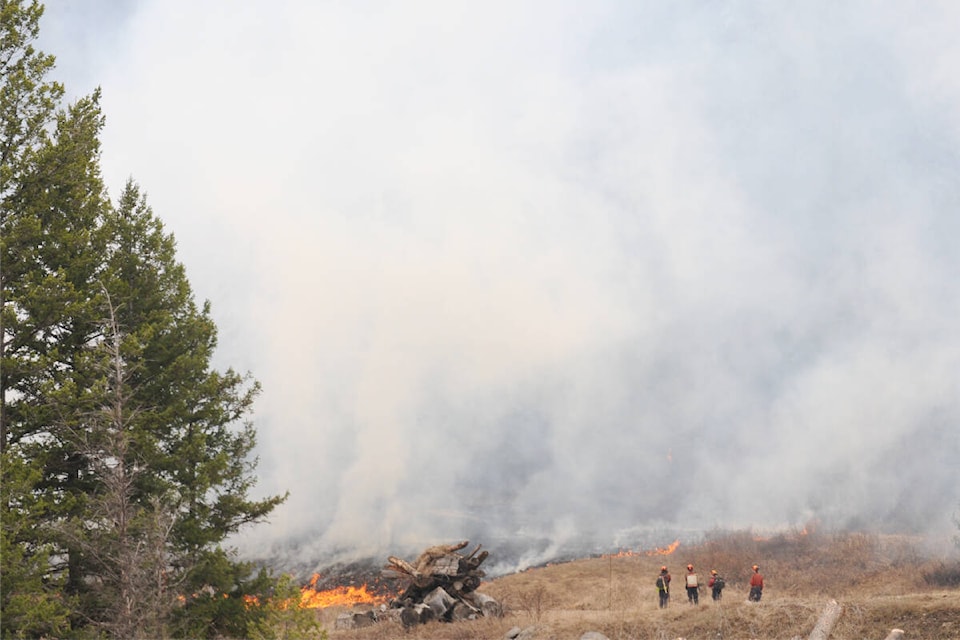The community of Williams Lake had a front-row seat to watch low-intensity fire across the landscape on April 6, 2022, with flames and smoke clearly visible from the city centre during a controlled burn.
After three days of site preparation, the 22 hectares below the heavily populated area of Westridge in Williams Lake and just above the Tolko mill log yard, fully stocked for the spring breakup season, was burned as part of an ecosystem restoration and fuel reduction project.
But it had taken far more to get everything in place.
“Peter has done a lot of work to make these burn plans happen,” said Steve Richburg, a wildfire officer with the Cariboo Fire Centre.
He is referring to Peter Holub, ecosystem restoration specialist with the range branch of the Province of British Columbia, who had conceived of the plan and put it all together.
“This is a model,” added Richburg, indicating the burn is being looked at closely by the province as something which could be applied province-wide.
Three days of pre-burning 20-50-foot wide “black lines” to contain the larger burn was one of the final steps to prepare the area, along with alerting the pubic using press releases which were then shared out through the media.
But prior to all of this, Holub had spent time creating the plan, partnering with the Cariboo Fire Centre and Williams Lake Fire Department.
They also worked with Williams Lake First Nation’s Fire Smart team so they could also gain some burning experience during the project.
Holub led the Tribune and others through the burn, to discuss the project and look over the result of the first burn.
Burning the area will help on a number of levels, explained Holub.
The burn will remove heavy fine fuels which are the highly volatile fuels which help fores fires spread rapidly.
These fuels build up when there is a history of fire suppression and a lack of grazing on the landscape. Reducing the fuel loading will help reduce fire intensity as well as slow the rate of spread if fire comes through during the peak fire season.
Burning the area will also help to restore the native grassland habitat.
“This is probably the most fuel I’ve seen in a grassland, just because of the lack of grazing,” Holub pointed out, kicking the matted grass underfoot and pointing to the number of low branches on the trees outside of the burnt area. These “ladder fuels” are what allow forest fires to move up into the crowns of trees, creating more dangerous and intense forest fires.
Some of the encroaching small trees and common juniper will hopefully die as a result of the burn, opening up the landscape once again.
“The Indigenous people burned these stands frequently,” said Holub, pointing out the age of the trees and how the spring cambium can make the small trees more vulnerable to being killed by the low-intensity burn, which in the case of grassland restoration, is a good thing.
The grasslands are an important and vital habitat which is disappearing and the planning Holub did included working on time frames with biologists to reduce the negative impacts on wildlife.
According to the Grasslands Conservation Council of British Columbia, only one per cent of the land base of B.C. is intact grassland, but these ecosystems provide habitat for over 30 per cent of the province’s threatened and endangered species.
Another goal of the 22-hectare burn was to reduce the fuel in preparation for mechanical treatment, which will involve thinning the forest stands over a larger area, including more heavily fuel-loaded and forested areas to the south and north of the burn.
After this preparation, the goal will be to burn the larger area to reduce fuel loading even more and continue to open up the landscape to more closely resemble historic habitat and then to burn these areas in the spring and fall.
“In order to have resilient communities, this kind of activity has to take place,” said Holub.
The entire city of Williams Lake and much of its surroundings were evacuated during the 2017 wildfires when forest fires threatened to cut off roads and burn down homes in the area.
The Cariboo Fire Centre is the control centre for wildland firefighting in the region and it had to be evacuated when the wildfires came close to the Williams Lake Airport, where the fire centre is based.
After these devastating wildfires, there has been an increased emphasis on fuel reduction and fire smart practices.
Read more: Fuel management work underway on outskirts of Williams Lake
ruth.lloyd@wltribune.com
Like us on Facebook and follow us on Twitter
